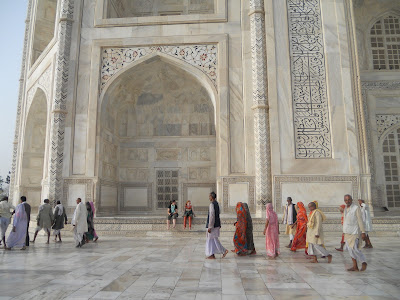I recently took a 9 day trip with a friend to Himachal
Pradesh, a northwest state in the western Himalayas. After exploring the tropical
south and the Rajasthani desert, I was drawn to the snowy peaks. I would have
preferred to go north when my knees were being paralyzed by the 110 degree
October heat in Mumbai, but the usually snow blocked roads in Himachal Pradesh
are only accessible in summer months.
 Rivers and glaciers surrounded us as we drove around this
state, whose peak elevation reaches 22,966 feet above sea level.
Rivers and glaciers surrounded us as we drove around this
state, whose peak elevation reaches 22,966 feet above sea level.
Getting around on buses and motorcycles, I feared for my
life as we spiraled up and down the steepest and narrowest mountainsides I have
ever seen. My knuckles were frozen white as I held onto the bottom of my seat.
(When one of our bus drivers got off the bus and returned with two bottles of
whiskey I thought of calling home to say bye to my family forever). But this
fear (which I often have here when I put my life in the hands of people whose
language and culture I don’t speak) dissipated as I looked beyond the edge of the
mountain to the breathtaking views. It was astonishing. (By the way, he didn't open the bottles...)
We spent a day in and around Shimla, previously British India’s
summer capital. While we enjoyed some horse riding and meandering through the
town, it was generally too kitschy so we continued on our itinerary to Manali. Manali
had a pleasant ambience, as a starting point for long treks. We spent a couple
of days riding my friend’s rented motorcycle up to snowy peaks and into
villages where we found short, attractive treks to waterfalls and hot springs.
Wrapping around snowy mountains, feeling the cold brisk on my face was so refreshing after 10 months in
sweltering Mumbai.
About half way through our trip we travelled to Manikaran, a
small town celebrated for its hot springs.
 |
| Hot Springs & Temples |
It’s interesting that more often than not bodies of water in
India have legends attached to them. In Hindu mythology, Manu was created as
the first man who gave life to all mankind. The most famous story involving
Manu relates to the great deluge that destroyed everything on earth. Some
remarkable connections to the story of Noah and the flood are that Manu was
told to build a ship to save himself and to bring two of each animal on board (one
distinction is that he was told to bring seeds from every type of plant as well).
It was in Manikaran where Manu is said to have recreated human life after the
flood. During our visit, Manikaran was crowded with pilgrims coming to visit
temples of Rama, Krishna and Vishnu. There was also an impressive gurudwara
(Sikh temple) there. While it was enjoyable to walk in and out of temples,
dipping my feet into the springs, it was more entertaining to watch Indians dip
bags of uncooked rice into the natural springs to boil them.
After Shimla and Manali we took a bus westward to
Dharamsala, home of the exiled Tibetan government and the Dalai Lama’s
residence. We arrived in the still dark early morning and ambled around McLeod
Ganj, the main village in Dharamsala. Tibetan exiles- monks, children and
women- walked past in orange and deep reds and greeted us with warm smiles. When
daytime stirred, we found ourselves a hotel and relaxed a bit after the long
overnight bus ride.
We spent a couple of days in McLeod Ganj visiting Bhuddist
temples, monasteries and a museum about the Tibetan exile. Watching monks debate
in the traditional Tibetan style was impressive. The choreographed clapping after
statements and the positioning of the defender and questioner’s robes are all
key elements to a debate. Similar to the positioning of a Kathakali dancer’s
eyes (see my post about Kerala), every hand motion and clothing position is
telling.
 |
| Offerings |
 |
| Bhuddist Temple Prayer Wheels |
On our last day we walked around the forests surrounding
McLeod Ganj. I ate my last momos (Tibetan dumplings) and breathed in as much of
the crisp air of northern India as I possibly could.
After a 9 hour overnight bus ride to Delhi, I looked back on
the journey with pleasure knowing that I had fresh memories and a broader
understanding of the ways of life within India’s far-reaching borders.































